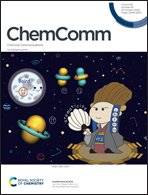Dimetalla-heterocyclic carbenes: the interconversion of chalcocarbonyl and carbido ligands†
Abstract
The μ-carbido complexes [Rh2(μ-C)Cl2(PPh3)4] and [Rh2(μ-C)Cl2(dppm)2] cleave CS2 to afford the monothiocarbonyl complexes [RhCl(CS)(PPh3)2] and [Rh2(μ-CS)Cl2(dppm)2]. The latter reacts with dimethyl acetylenedicarboxylate (DMAD) to afford [Rh(μ-CS)(μ-DMAD)Cl2(dppm)2]. This complex is also formed from [Rh(μ-C)(μ-DMAD)Cl2(dppm)2] and sulfur. These strategies also afford the first rhodium selenocarbonyl complexes [Rh(μ-CSe)Cl2(dppm)2] and [Rh(μ-CSe)(μ-DMAD)Cl2(dppm)2].



 Please wait while we load your content...
Please wait while we load your content...